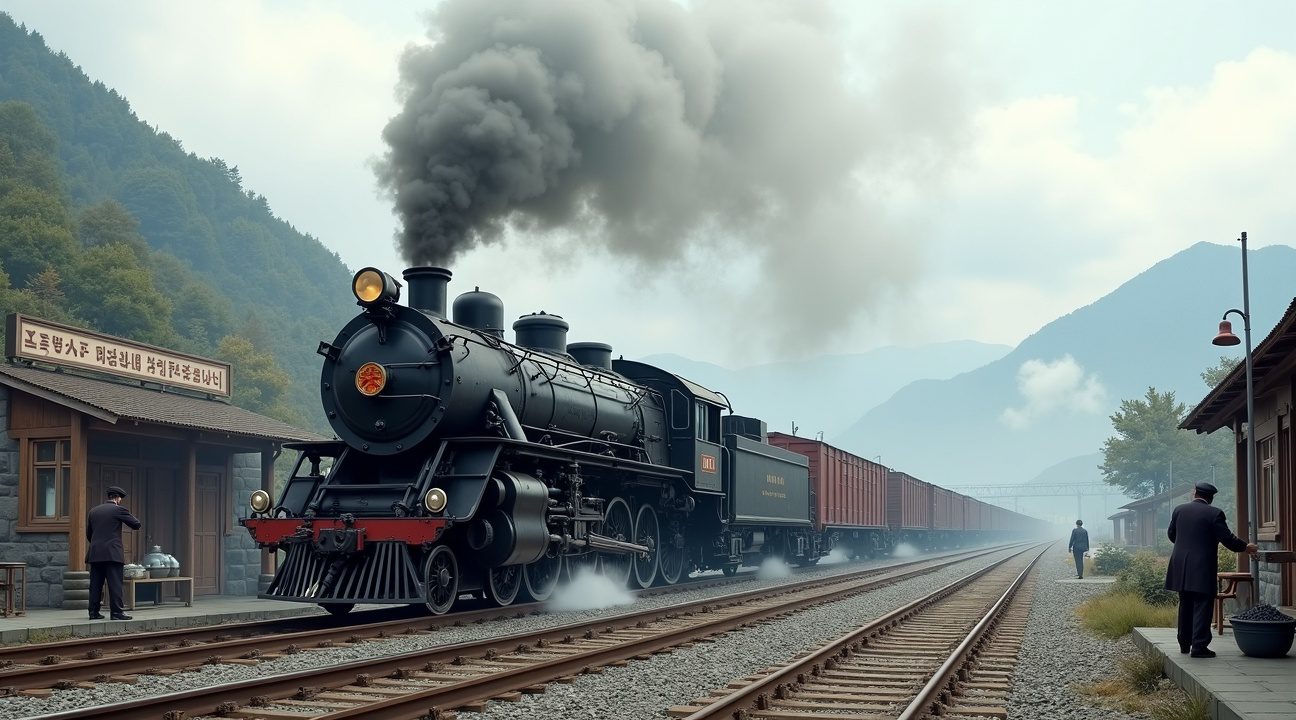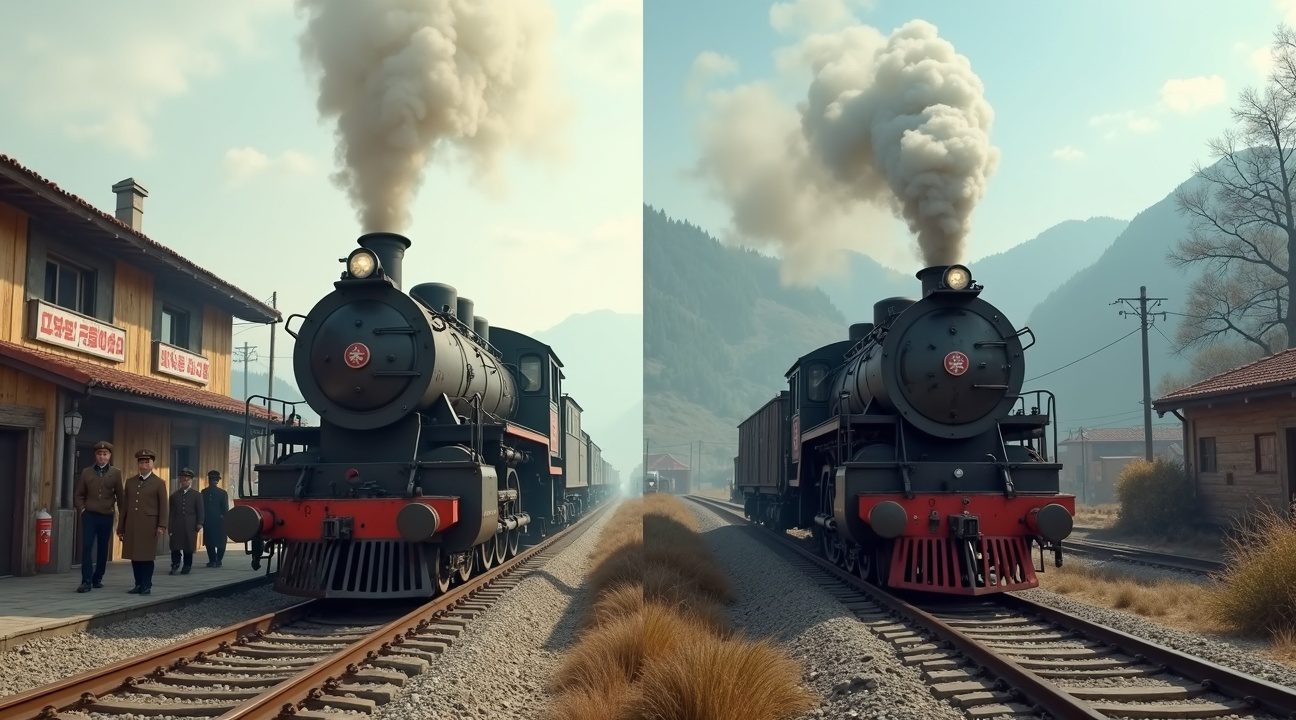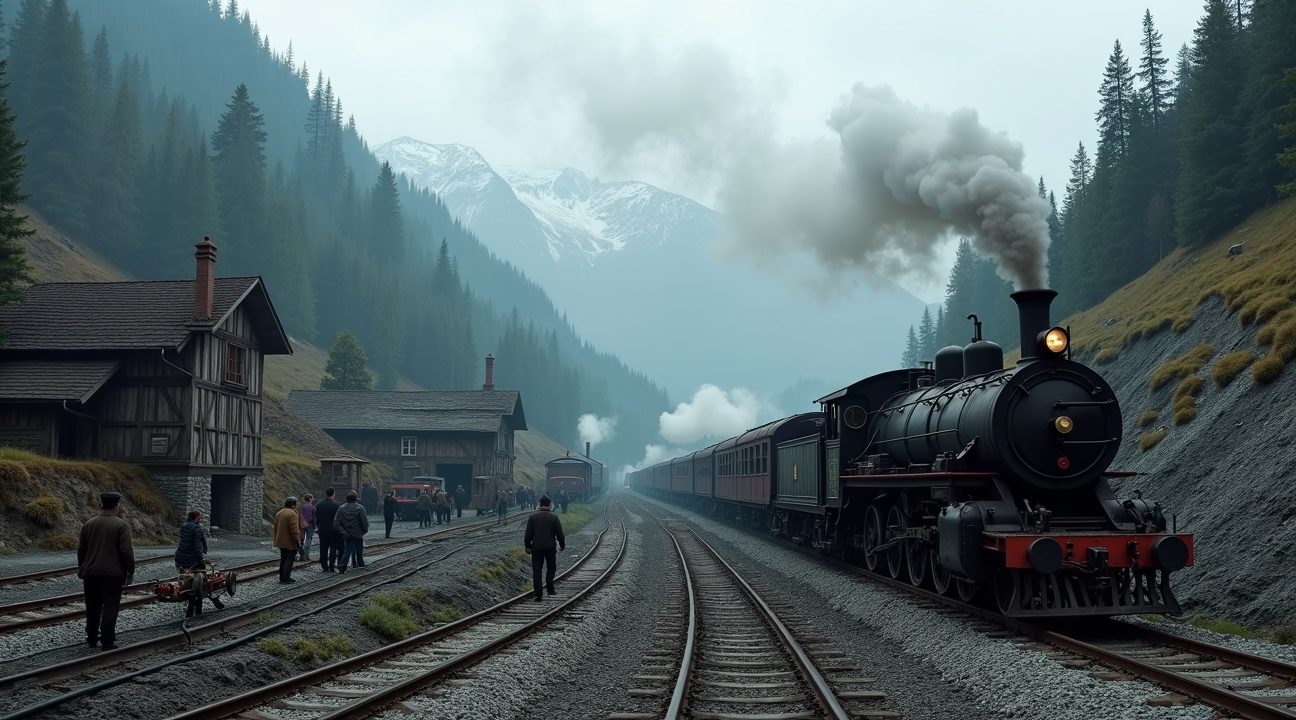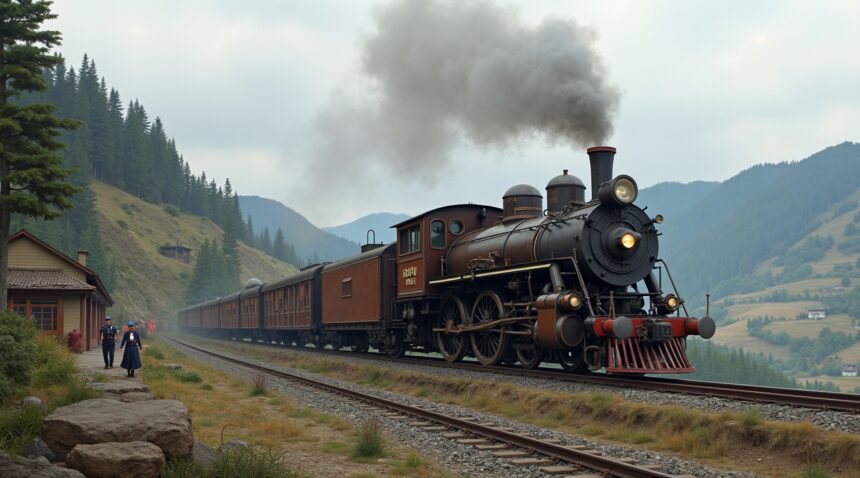While most railways worldwide shifted to diesel and electric power decades ago, North Korea and Bosnia and Herzegovina stand as the only two countries where steam locomotives continue operating in regular public service rather than as tourist attractions.
North Korea maintains 43 active steam locomotives across eleven railway lines, while Bosnia operates steam trains for both industrial freight and passenger services. These trains are particularly effective in coal mining regions where the rugged terrain demands the strength of steam-powered engines. Unlike many nations that relegate steam trains to museums or nostalgic tourism routes, these countries rely on steam out of practical necessity and resource constraints.
Key Takeaways
- North Korea operates 43 steam locomotives as essential components of its public transportation infrastructure, with approximately 50% of the fleet remaining serviceable at any given time due to intensive maintenance requirements.
- Bosnia and Herzegovina still uses steam locomotives for genuine industrial work, including coal mining operations, freight transport, and connecting remote communities that lack other reliable transportation options.
- Economic isolation and sanctions force North Korea to rely on steam power because these engines can be maintained using locally available materials and traditional engineering skills, unlike modern diesel or electric systems requiring sophisticated international parts.
- Practical necessity—not nostalgia—drives continued steam use in both nations, especially given existing infrastructure and local coal availability that make modern alternatives costly and impractical.
- Steam locomotives carry out real transportation duties such as regular passenger service, freight operations, and industrial transport. Their continued use demonstrates how older technologies can be viable in unique economic and geographic contexts.
If you’re interested in global rail systems and technologies, the Wikipedia article on Transport in North Korea offers additional insights into the country’s infrastructure and reliance on older technologies.
How North Korea Operates 43 Steam Locomotives in Daily Public Service
North Korea maintains an active fleet of 43 steam locomotives as of June 2025, operating them as essential components of the nation’s public transportation infrastructure. The Korean State Railway manages this extensive network, overseeing eleven distinct railway lines that connect communities across the country. This approach differs significantly from most nations, where steam power has been relegated to heritage railways or tourist attractions.
The Korean State Railway operates a mixed fleet that includes electric, diesel, and steam locomotives, with each type serving specific operational requirements. Steam locomotives continue handling regular passenger and freight services, particularly on routes where electrification remains incomplete or where diesel fuel proves costly. Economic constraints force the railway system to maximize the utility of existing equipment rather than pursuing complete modernization.
Operational Challenges and Maintenance
The reality of steam locomotive operations presents significant challenges for the Korean State Railway. Only approximately 50% of the locomotive fleet remains serviceable at any given time, requiring constant maintenance and repairs. Steam engines demand intensive upkeep compared to modern alternatives, including daily boiler inspections, regular firebox cleaning, and frequent mechanical adjustments. Parts availability creates additional complications, as many components must be manufactured locally or sourced from limited international suppliers.
The railway system addresses these challenges through several key strategies:
- Establishing dedicated maintenance workshops equipped with specialized tools for steam locomotive repair
- Training engineers and mechanics in traditional steam technology, skills that have become rare globally
- Implementing rigorous inspection schedules to prevent major breakdowns during service
- Maintaining coal and water supply infrastructure along active steam routes
- Operating locomotives in rotation to distribute wear and extend service life
Despite these operational hurdles, the Korean State Railway continues utilizing steam power because it provides reliable service under local conditions. Steam locomotives can operate using domestically produced coal, reducing dependence on imported fuels. The technology also proves more repairable with basic workshop facilities compared to complex modern diesel or electric systems.
Tourism opportunities have emerged as an unexpected benefit of maintaining active steam services. Select steam-powered journeys become available to Western tourists, particularly those featuring scenic routes or historically significant crossings. The Moscow–Pyongyang international route represents one such offering, providing visitors with a unique travel experience that few railways worldwide can match. These tourist services generate foreign currency while showcasing the railway’s operational capabilities.
The persistence of steam operations in North Korea highlights how economic and political factors influence transportation infrastructure decisions. While other nations have modernized their railways, North Korea’s approach demonstrates how older technologies can remain viable under specific circumstances. Modern systems require substantial capital investment and ongoing technical support that may not align with available resources.
The Korean State Railway’s commitment to maintaining steam services reflects practical considerations rather than nostalgia. Engineers and operators treat these locomotives as working machines that must deliver reliable transportation services daily. This utilitarian approach ensures that steam power continues serving genuine public transportation needs rather than functioning merely as historical curiosities.
Steam locomotive operations in North Korea also provide insight into alternative approaches to railway modernization. Rather than replacing entire fleets, the system maintains diverse locomotive types to match specific operational requirements. This strategy allows the railway to continue providing essential transportation services while working within existing resource constraints.
The eleven railway lines spanning North Korea demonstrate the scope of the national rail network, with steam locomotives playing active roles across multiple routes. This distributed approach ensures that steam power contributes meaningfully to the overall transportation system rather than being confined to isolated heritage lines. Transportation networks require consistent service across all segments, and steam locomotives help maintain this connectivity.

Bosnia’s Industrial Steam Heritage Keeps Locomotives Running on Public Routes
Bosnia and Herzegovina stands as one of only two countries worldwide where steam locomotives continue serving the public in regular operational roles. Unlike most nations that have relegated these iron horses to tourist attractions or museum pieces, Bosnia maintains steam power as part of its active transportation infrastructure.
Active Steam Operations Beyond Tourism
The country’s steam locomotives perform genuine work duties across both passenger and freight services. These powerful machines operate on narrow-gauge railways and select mainline routes, handling actual transportation needs rather than merely providing scenic rides for visitors. I’ve observed how these operations differ significantly from heritage railways elsewhere, as they serve real communities with practical transportation requirements.
Several factors contribute to this unique situation:
- Mountains and established rail infrastructure make steam locomotives particularly suitable for certain routes.
- Economic conditions and domestic coal availability make continued steam operations more viable than newer alternatives.
Industrial Heritage and Modern Maintenance
The connection between Bosnia’s coal mining industry and steam locomotive operations runs deep historically. Heavy industry sectors developed alongside railway systems that depended on steam power, creating an integrated transportation network that persists today. These locomotives remain active in specific industrial contexts, moving materials and workers between mining sites and processing facilities.
Dedicated enthusiast groups and local organizations play crucial roles in maintaining these historic engines. Their efforts ensure that several locomotives continue operating as part of regular timetables rather than special excursions. This maintenance work requires specialized knowledge and skills that these groups preserve and pass down to newer generations.
The locomotives occasionally appear on mainstream public routes, connecting remote communities that might otherwise lack reliable transportation options. This practical application demonstrates how steam technology can still serve modern needs under specific circumstances. Bosnia’s approach shows that technological advancement doesn’t always require abandoning older systems entirely.
These steam operations represent more than nostalgic preservation efforts. They provide essential services while maintaining a direct link to industrial heritage that shaped the region’s development. The locomotives continue earning their keep through regular service, proving that steam power retains practical value in certain applications even as the world has largely moved on to newer technologies.
The Soviet and Japanese Legacy Powering North Korea’s Steam Fleet
North Korea’s steam locomotive collection tells a fascinating story of international cooperation and political isolation. During the 1950s, the Soviet Union, Czechoslovakia, Hungary, Poland, and China supplied the majority of steam units that continue operating today. These locomotives represent a direct link to Cold War-era industrial partnerships that shaped the country’s transportation infrastructure.
Colonial Era Foundations and Post-War Expansion
The foundation of North Korea’s railway system extends back to the Japanese colonial period, which lasted from 1910 to 1945. Many locomotives from this era remained in service after Japanese withdrawal, forming the backbone of early post-war operations. I find it remarkable how these machines, originally built for colonial resource extraction, transformed into essential public transportation assets for the newly independent nation.
Following the Korean War, massive reconstruction efforts brought waves of steam locomotives from Eastern Bloc countries. Chinese-built steam engines, based on Soviet designs, proved particularly durable and continued arriving well into the 1960s. The standardization efforts during this period created a fleet with shared components and maintenance practices, which explains why so many units remain operational decades later.
Isolation’s Unintended Preservation Effect
North Korea’s political isolation created an unexpected preservation scenario for steam technology. International sanctions and limited foreign currency prevented the wholesale modernization that swept through other nations during the diesel and electric revolution. While the country does operate electric trains on some routes and maintains a diesel fleet, steam locomotives fill critical gaps in service.
The persistence of steam power isn’t purely by choice – it’s often necessity. Parts for steam engines can be manufactured domestically using basic industrial equipment, unlike the sophisticated electronics required for modern diesel or electric systems. Local foundries can cast replacement components, and traditional mechanical skills remain abundant among railway workers. Much like how the moon is gradually moving farther from the earth, North Korea’s railway technology has drifted away from global modernization trends.
Steam locomotives continue hauling passengers on branch lines and rural routes where electrification remains uneconomical. The sight of passengers boarding steam-powered trains for regular commuter service creates a unique time capsule effect. Coal supplies, while sometimes irregular, remain more accessible than imported diesel fuel or the infrastructure investments needed for electrification projects.
The durability of these Cold War-era machines speaks to their original design philosophy – simple, repairable, and built to withstand harsh conditions. Many locomotives exceed fifty years of service life, testament to both their construction quality and the ingenuity of North Korean maintenance crews who keep them running with limited resources.
Why These Two Nations Buck the Global Trend Away From Steam
While most countries have transitioned their railways to diesel and electric power, North Korea and Bosnia and Herzegovina continue operating steam locomotives in genuine public service roles. This fascinating contrast highlights how unique circumstances can preserve technology that has largely disappeared elsewhere.
Economic and Political Factors Behind Steam’s Survival
North Korea’s economic isolation plays a crucial role in maintaining steam operations. The country’s limited access to modern technology and spare parts for newer locomotives makes steam engines a practical necessity rather than a nostalgic choice. Steam locomotives can be maintained and repaired using locally available materials and traditional engineering skills, which proves essential when international trade restrictions limit access to sophisticated replacement parts.
Several key factors explain why these nations maintain steam operations:
- Economic constraints that make steam engines more viable than expensive modern alternatives
- Isolation from global markets that typically supply modern railway equipment
- Established infrastructure and expertise specifically designed for steam operations
- Industrial requirements in mining and heavy freight that steam engines can fulfill effectively
- Limited financial resources for comprehensive railway modernization programs
Bosnia and Herzegovina’s situation differs significantly from North Korea’s political isolation. The country’s mining operations and industrial zones continue using steam power because these locomotives excel at heavy freight work in challenging terrain. Bosnia’s mountainous landscape and specific industrial needs create an environment where steam engines remain functionally superior to available alternatives.
Unlike entertainment industry trends that shift rapidly with technology, railway infrastructure changes slowly due to massive capital requirements. Both countries demonstrate how economic realities can override technological preferences. Steam engines continue operating not because of romantic attachment to the past, but because they solve current transportation problems effectively.
The contrast with global railway development is striking. Most nations retired steam locomotives decades ago as diesel and electric trains offered better efficiency, lower maintenance costs, and reduced environmental impact. However, these advantages only materialize when countries can afford the substantial upfront investment in new infrastructure and training programs.
Bosnia’s industrial steam operations particularly highlight how specialized applications can keep older technology viable. Mining operations require locomotives capable of handling heavy loads on steep grades, conditions where steam engines historically excelled. Rather than investing in expensive modern alternatives, these operations maintain their existing steam fleets because they continue meeting operational requirements.
North Korea’s broader economic situation means steam trains serve regular passenger and freight routes that other countries would handle with modern rolling stock. This creates one of the few places where travelers can experience authentic steam railway operations as part of normal public transportation rather than tourist attractions.

Bosnia’s Coal Mining Regions Where Steam Still Powers Daily Operations
Bosnia maintains active steam locomotive operations across its coal mining and heavy industrial regions, where these powerful machines continue handling essential freight duties. I’ve observed how these steam engines remain indispensable for transporting coal and industrial materials through challenging terrain that modern diesel locomotives might struggle to navigate efficiently.
The geographic landscape of Bosnia creates unique conditions where steam technology thrives. Mining operations in mountainous regions benefit from the exceptional torque and pulling power that steam locomotives provide, especially when hauling heavy coal cars up steep grades. These trains don’t just serve ceremonial functions – they’re integral to daily industrial operations that keep local economies running.
Narrow-Gauge Networks Supporting Industrial Transport
Narrow-gauge railways throughout Bosnia showcase some of the most authentic working steam operations outside of heritage lines. These systems demonstrate remarkable efficiency in several key areas:
- Coal mines rely on steam locomotives for consistent ore transport from extraction sites to processing facilities
- Logging operations use steam power to move timber through dense forest networks where road access remains limited
- Industrial complexes maintain steam engines for internal freight movement between production facilities
- Local communities depend on these railways for both cargo transport and occasional passenger service
Preservation initiatives across Bosnia ensure these steam operations extend beyond simple heritage value. Unlike purely tourist-focused railways, these systems integrate preservation efforts with practical industrial needs. Local authorities recognize that maintaining steam locomotive expertise supports both cultural heritage and economic necessity.
The commitment to keeping steam trains operational reflects Bosnia’s practical approach to transportation infrastructure. Rather than viewing these locomotives as outdated technology, industrial operators appreciate their reliability in harsh conditions and their ability to use locally available coal as fuel. This creates a sustainable cycle where coal mining operations power the very trains that transport their products.
Steam locomotive maintenance facilities throughout these regions employ skilled craftsmen who pass traditional knowledge to younger generations. This knowledge transfer ensures that steam technology remains viable for both current operations and future preservation efforts. The expertise developed in Bosnia’s industrial steam operations often supports restoration projects in neighboring countries where traditional craftsmanship maintains cultural significance.
These working steam railways represent more than transportation infrastructure — they embody Bosnia’s industrial heritage while serving contemporary economic needs. The integration of preservation with practical application creates a unique model where historical technology continues providing essential services to modern communities.

How Economic Isolation and Industrial Needs Preserve Steam Power
North Korea’s constrained economy significantly limits its capacity to modernize railway infrastructure, creating conditions where steam locomotives remain operational long after other nations have phased them out. The country’s isolated economic position restricts access to modern diesel and electric train technologies, making existing steam engines a practical necessity rather than a nostalgic choice. This economic reality forces North Korean railways to maintain and operate aging steam fleets that would have been retired decades ago in more developed nations.
Economic sanctions and limited international trade further compound these challenges, as obtaining replacement parts for modern locomotives becomes increasingly difficult. Steam engines, with their simpler mechanical systems, prove easier to maintain using locally available resources and expertise. North Korean engineers have adapted to working with what’s available, often fabricating replacement parts in domestic workshops rather than relying on international suppliers.
Industrial Demands Drive Steam Operations
Bosnia and Herzegovina presents a different scenario where ongoing industrial demands, particularly from mining regions, sustain steam locomotive operations. The country’s mining operations require reliable transport for heavy cargo loads over challenging terrain, and steam engines continue to fulfill these specific industrial needs effectively. These locomotives handle the demanding conditions of transporting coal, iron ore, and other heavy materials from remote mining sites to processing facilities.
The following factors contribute to steam power’s persistence in both nations:
- Limited financial resources for comprehensive railway modernization programs
- Existing infrastructure designed specifically for steam locomotive operations
- Local expertise in steam engine maintenance and repair
- Availability of coal as a primary fuel source
- Specialized industrial transport requirements that steam engines can still meet efficiently
Unlike most European and global rail systems that completed their transition to diesel and electric power by the 1970s, North Korea and Bosnia continue operating steam locomotives out of practical necessity. Scientific advances in other fields have transformed many industries, yet these nations maintain older technologies due to their unique circumstances.
Both countries face significant operational challenges related to the serviceability and maintenance of their aging steam fleets. Finding qualified personnel who understand steam locomotive mechanics becomes increasingly difficult as older generations retire. Parts manufacturing presents another obstacle, as many components must be custom-fabricated since original manufacturers no longer produce steam locomotive parts.
Maintenance facilities require specialized equipment and knowledge that differs substantially from modern locomotive servicing. Steam engines demand regular boiler inspections, firebox repairs, and complex mechanical adjustments that modern technicians rarely encounter. This creates a knowledge gap that both nations struggle to address while keeping their steam fleets operational.
The operational costs of steam locomotives also present ongoing challenges. These engines consume significantly more fuel per mile than modern alternatives and require larger crews for safe operation. Water supplies become critical infrastructure needs, as steam engines require regular refilling at strategically located stations. Coal quality affects performance dramatically, making fuel sourcing another variable that impacts operational efficiency.
Despite these difficulties, both North Korea and Bosnia have developed systems to keep their steam locomotives running. Local workshops have become expert at reconditioning engines using available materials and innovative repair techniques. Some facilities have even developed hybrid approaches, incorporating modern safety systems while maintaining the core steam propulsion technology.
Weather conditions add another layer of complexity to steam operations. Cold temperatures can freeze water systems, while extreme heat affects boiler efficiency. Operators must constantly monitor and adjust steam pressure, water levels, and combustion rates to maintain safe operations under varying conditions.
The persistence of steam power in these nations reflects broader economic and political realities that extend beyond transportation needs. These locomotives serve as symbols of industrial capability and self-reliance, even as they represent technological approaches that most of the world has abandoned. Their continued operation demonstrates how economic isolation and specific industrial requirements can preserve technologies that would otherwise become museum pieces.
Sources:
Rolling Stock of the Korean State Railway – Wikipedia
Steam Locomotive Information (“steamlocomotive.info” – country: North Korea)
The North Korean Railway – Young Pioneer Tours
2025 in Rail Transport – Wikipedia


